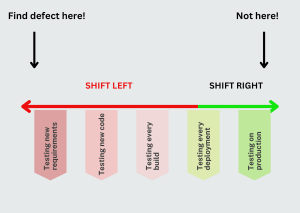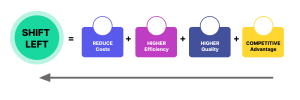Shift left testing: Why early is always better (In Tech and in Life!)
Imagine it’s the wedding season and this year it’s your turn to face the daunting task of planning a big Indian wedding. There’s a million things to do on the checklist so you try to start your preparation months in advance—booking the venues, finalizing the caterers, shopping for outfits, and deciding on the guestlist early. Why? Because if you wait till the last minute, everything turns into chaos—missing decorations, food disasters, and that one distant relative who didn’t get the invite is now offended for life! Not only this, lack of preparation can leave you feeling super stressed on a day that is supposed to be one of the happiest for you. What a nightmare!

Calvin and Hobbes discussing last-minute panic.
The idea of starting early to avoid last-minute mess is exactly what Shift Left Testing is all about in the software world. Instead of testing at the very end of development, the Shift Left approach supports testing from the very beginning—catching bugs at the earliest stages, saving time, and reducing costs. But not just this, even beyond tech, this early detection and prevention mindset can be a game-changer for you in many real-life scenarios as well.
Let’s try to break it down to see why it’s an approach worth adopting everywhere—whether you’re testing an app, planning a wedding, or just managing your day-to-day.
What is Shift Left Testing?
Not too long ago, software testing was something that was taken up at the end of the development cycle. Teams would spend weeks or months brainstorming and building a product, and only after the development was done, then would the testers start checking for bugs. By that time, any issue found would end up needing a costly fix and also very time-consuming- time that can be better spent on improving the product for future versions.
Around 2001, author Larry Smith, coined the term Shift Left testing. An approach that flipped the whole process by moving testing earlier (to the left side of the software development timeline). Developers write tests right from the planning and coding phases instead of waiting for the end. This way, bugs are caught early—before they turn into major problems.
In simple words: “The sooner you find the problem, the quicker and easier its fix will be!”

Shift-Left Testing approach timeline
How is Shift Left Testing Used in the Real World?
Now let’s look at some real-world examples—both in tech and outside it—where Shift Left Testing (or the “early prevention” mindset) make a massive difference.
1. Banking & FinTech Apps
India in recent years has seen a digital revolution and a huge surge in digital payments. Apps like UPI, Paytm, PhonePe, etc. have popped up hoping to capture the huge market of smartphone owners in India. The goal of these apps is to provide convenience and hassle-free payments at your fingertips. To do this, these apps of course need to be secure, fast, and error-free. A bug in the code can possibly lead to failed transactions or worse—security breaches.

Growth of Digital Payments in India
Where Shift Left comes in:
- Developers now run security tests while coding, not after its completion.
- Automated testing ensures any possible errors in transactions are detected early and quickly.
- Early performance tests help in handling festival-season traffic (like Diwali season or concert ticket bookings) and makes the business more scalable.
- This means fewer failed transactions that in turn mean happier customers, and more trust in the brand- which ultimately leads to better business!
2. Food Delivery Startups & E-commerce (Flipkart, Zomato, Swiggy)
Imagine ordering biryani on Swiggy, and instead of Hyderabad Dum, you get Veg Pulao (Ew!). Disappointing, right? Issues like this can arise due to last-minute testing failures in either the app or backend systems.
How Shift Left helps:
- New features (like “Quick Delivery”) are tested from day one to avoid any possible order delivery failures.
- AI-driven automation tests ensure personalized recommendations are up to mark and actually help in boosting sales.
- Bugs are fixed before the sale day—not after customers start complaining and tagging the CEO on Twitter!
- By catching problems early, such consumer-service based companies can prevent bad customer experiences and loss of trust, leading to a higher return rate.
3. Education & Personal Growth
It’s not just for businesses—Shift Left is really a mental model! For example, most of us at some point have left the preparation for an upcoming exam to the last-minute and maybe because of this got really stressed out and ended up pulling an all nighter to study.
This almost always results in a rushed sleep-deprived attempt to get to the end of the question paper as quickly as possible.

Exam Panic
A Shift Left approach would be:
- Taking smaller mock tests regularly instead of cramming at the end.
- Getting an idea about your weak areas early.
- Working on making improvements before it’s too late.
The result? Better performance, less stress, and increased interest in learning.
Implementing Shift Left Testing in Tech & Beyond
So, how can companies and individuals start applying this approach? Here’s some pointers:
1. Automate Your Testing Early
- Instead of manually testing everything at the end, use tools like Selenium or JUnit from the beginning.
- Automate security checks so vulnerabilities are already known and don’t pile up.
2. Continuous Feedback Loops
- In software, involve the QA team right from the design phase.
- In real life, don’t wait till the annual performance review—try to give and receive feedback frequently. TTN’s monthly mentor check-ins are a great example of this!
3. Early Risk Assessment
- Identify risks in projects at the idea stage instead of after major developments are done.
- Think of it as financial planning—investing early in SIPs instead of scrambling for money at retirement.

Shift-Left testing advantages
Why Shift Left is a great hack for success!
If you think about it, Indian culture has always had elements of Shift Left thinking sprinkled across various aspects of our society. You might have heard your elders always advise you to plan early for marriage, save money in fixed deposits, and start career prep years in advance.
This mindset is not just about coding—it’s about thinking ahead, catching problems early, and ultimately ending up making smarter decisions. Whether you’re a tester, a business owner, a student, or any working professional, applying this mindset can have immense benefits:
- Avoiding last-minute panic and stress.
- Saving time, money, and effort
- Improving quality of whatever you do.
So the next time you’re working on a project, planning a big event, or even preparing for an exam, try to Shift Left a little. Your future self will thank you.
Final Thoughts:
Shift Left Testing isn’t just a software practice; it’s a philosophy that helps in tech, business, and life. Whether you’re developing an app, running a company, or just planning your future, addressing issues early always leads to better results!

